YOUR NAME
The Return of Martin Guerre
dir. Daniel Vigne, 1982
Part One: Brief Description of Film Clip
The Clip: The opening four minutes of the film are composed of four sections that together make up a double prologue and double beginning: the first prologue involves a man riding into the village as the credits are shown (one minute and thirty-eight seconds); the second sequence seems to begin the film proper, as we see a marriage inside a church (one minute and eighteen seconds); yet the third sequence returns the notary as he dismounts and moves toward a house and we hear in voice-over what turns out to be a second prologue affirming that this is a true story (thirty-three seconds); in the fourth sequence, the movie proper finally "begins" (for the second time) with the signing of the wedding contract by both fathers (one minute and eighteen seconds).
Total Length: Four minutes and thirty-eight seconds
Begins: 00:00
Ends: 4: 38
Total number of shots: 37
Part Two: Shot by Shot Description
| Shot |
Image Captured |
Time STAMP DVD or streaming |
Length of Shot |
Description of Shot (kind of shot--extreme close up, close up, medium, long, p.o.v.); camera movement, stationary, pan, tilt, whip pan, dolly in, dolly out, crane, tracking; camera angle--high, low, canted or Dutch, straight on, overhead, from below; sound--ambient, diegetic; extra-diegetic, kind of music, if any; voice-offs and voice-overs; editing--transition from one shot to another (dissolve, fade, wipe, cut, cut in, and so on); super-imposition; sequence--linear, montage, flashback; mise-en-scène; framing and reveals--what is in hte shot and what is not; lighting--source, contrast; blocking; camera focus--racking, spot, soft, or deep; length of take, and so on and so on.
Columbia Film Language Glossary
Yale Film Analysis
|
Annotation |
| 1 |
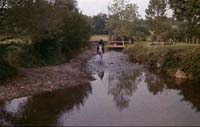 |
Chapter One 00 |
23 seconds |
Shots 1-7 constitute the first prologue. The film begins with a LS (Long shot, or here, establishing shot); camera remains stationary; no
music, only the horse splashing is heard in what initially looks like a placid stream. |
The first shot of the film is held for an unually long time, and is by far the longest shot of the opening sequence. Given that we know the title of the film before we have begun watching it, the opening shot invites us to wonder--by focusing for so long on this man on a horse--who the rider is. Is he Martin Guerre? Or someone else? Is the rider returning or leaving? Form where and to here? |
| |
 |
|
|
|
The camera seems oddly still as the rider leaves the frame. Why doesn't the camera move and follow him? The film is shot enitrely on location in this village and the court in Toulouse. We never get scenes providing "flashbacks" of Arnaud's "memories" as Martin. The reflection offered by the stream gradually becomes less clear as the horse walks through it. |
| |
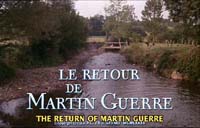 |
|
|
Somewhat eerie extradiegetic music, sounding both modern and Renaissance, begins to play as the film title appears. |
The music continues to play until the credits are finished (shot 8). The music combines low, oboe tones with high pitched wails and percussion. It is not particularly melodic; more moody.The composer, Michel Portal, is credited for original music at 01:30; music recorded by editions des Alouettes et Devout Music. After the rider's disappearance, the film's dramatically introduced title raises more pointedly the question of whether he is (or was) Martin Guerre. or is the rider simply making way for Martin's return? The music initially appears to be also diegetic as the geese to the right fly off, as if disturbed by it. Natural beauty has been disturbed by a human's presence. |
| 2 |
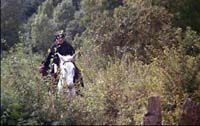 |
00:24 |
6 seconds |
MLS (Medium Long Shot), camera follows the rider in medium close up, panning right. |
The rider gradually moves closer to the frame. |
| 3 |
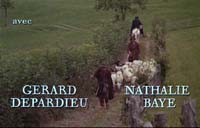 |
00:30 |
8 seconds |
Camera remains stationary, LS, camera slightly elevated, as the rider gets closer to the village. |
The absence of any panoramic shot initially makes it difficult for us to tell just where this rider is, how far from his destination. The two stars get equal billing space and time, though Depardieu gets a small advantage due to his name being on the left (out of alphabetical order). |
| 4 |
 |
00:39 |
14 seconds |
MCU (Medium Close Up), camera follows rider, whose face we can see clearly now,
to the left and then tracks him as he goes into the village |
Undeveloped landscape and costumes make the film seem more authentic; no Hollywood anachronisms visible. |
| |
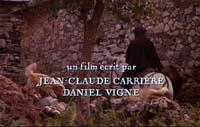 |
|
|
A dog appears near the end of the shot, one of many animals seen as the rider enters
the village. |
Vigne's name will appear again in shot 7. The names here are vertical and in alphabetical order. The dog reappears shortly playfully fighting another dog
(shot 27).
This is apparently a dog eat dog world. |
| 5 |
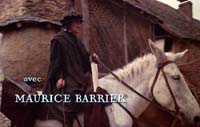 |
00:53 |
20 seconds |
Camera tracks rider, pretty close up, as he goes to the right
and then camera comes to a stand still as it watches the rider go into the
village and past two men, one of whom doffs his hat and bows to the rider. |
We begin to get more of a sense of the rider; he is evidently a man of authority. Yet he is far enough from where he usually exercises his authority that not every one defers it. Power has it limits; it does not seem to reach everywhere. |
| 6 |
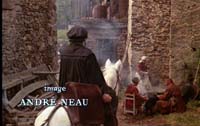 |
01:13 |
14 seconds |
Camera stationary. Cut back to the rider in medium close up, as if the camera
were catching up with him, and we now see a group of women cooking. |
The rider does not greet the women, nor they him. He seems to be a stranger. |
| |
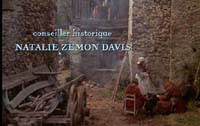 |
|
|
|
Natalie Zemon Davis's name and her title "historical consultant" appear (for 1.5
seconds) in this shot after the rider has left the frame (the last 2 seconds of the shot), linking her to the women in the shot. |
| 7 |
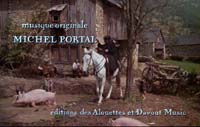 |
01:27 |
12 seconds |
Another stationary camera shot, like the opening shot; medium LS
of the rider crossing a pond with pigs in it. |
A dirty pond now replaces / echoes the stream the rider crossed in the opening shot. The rider and one of the men greet
one another. The rider is evidently not a complete stranger and is evidently making another trip to the village, though not returning to it as place of residence. |
| |
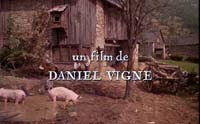 |
|
|
Director Daniel Vigne's name appears after the rider moves
out of this shot, as he has done twice before. In this case, the rider is entirely out of the frame at 1:34 and the shot continues for four seconds until the cut to the Church (shot 8) at 1:38. |
Vigne's name appears near pigs, and is held for three seconds (other crew and actors get .5 to 2 seconds). The French credits (not translated) blur the difference between director ("auteur," in French) and screenplay writer. It's "un film ecrit par" and "un film de"--"a film written by" and "a film by." |
| 8 |
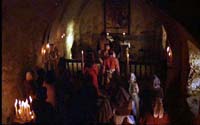 |
01:39 |
11 seconds |
Shots 8-22 constitute the first beginning. Stationary camera, long shot; the faces of Bertrande and Martin
are shown last in this sequence; no extradiegetic music, only the priest's voice-over i sheard; dramatic shift from brightly lit, sunny outside to dimly lit (candles) interior.The film narrative proper appears to have begun now that the credits are finished. The shots are all relatively brief, just long enough so that we can see who is who (they are similar in this respect to the credits). |
Though Shots 8-22 are marked as a move into the film, shots 11-14 are another kind of prologue: they perform quite unobtrusively and economically the function of explaining to us when and where we are (St Michael's Sunday in the church of Artigat) and introducing us to the main characters of the story. For a louder, more obtrusive version of this function, see the second prologue (repeated in voice-over) of Baz Luhrmann's William Shakespeare's Romeo + Juliet (1996). The end of the extradiegetic music with this shot is another authenticating gesture: No fake, emotive symphonic music here. With this shot (8), we might now reasonably conclude that the rider has come to the village to attend this marriage. We are partly right, yet he is not in the church, where we might now expect to find him (via a flashforward cut from the preceding shot). Suspense is heightened in this sequence as the faces of Martin and Bertrande are withheld while we first see the faces of the priest and the parents and guests. Similarly, we later first see Arnauld / Pansette (Gerard Depardieu) shot from the back as he "returns" to the village. Since this is the adult Martin and film convention dictates that a different actor play the adult character (as a new actress plays the adult Bertrande), we can't be sure whether this man is or is not Martin. The marriage itself and the number of people present tell us that there is a significant union of two major families. |
| 9 |
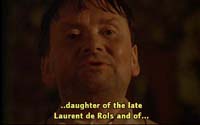 |
01:50 |
3 seconds |
The priest gets the first close up of the film, and the camera is stationary; only the
priest's words continue to be heard. |
The voice-over is not located in a particular character, the priest (?). As a priest performing speech acts, the male voice here is given authority. Yet male authority is already being subtly undercut in this scene. We might have expected the rider to be present. He isn't. The priest's first introduction of a parent is his announcement of a dead father (later we hear of Martin's father's death, and Arnauld is executed after having given birth to a son and been stepfather to another; the real Martin is a cuckold and a father with a peg leg). There is a lot of continuity in shots 11-14. This part of the film, all shot in the same space, is easy to follow compared to the opening credits. |
| 10 |
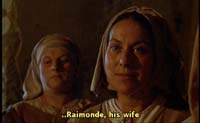 |
01:53 |
2 seconds |
Another CU, stationary camera; names on voice over and subtitles are
being matched to the faces of characters. |
The first parent we see is a mother (?). Introductions to the parents precede our introduction to the married couple. |
| 11 |
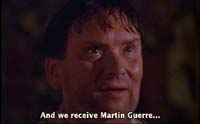 |
01:55 |
3 seconds |
Another CU, stationary camera, of the priest. |
Names in voice-over and subtitles are being matched to the faces of characters. |
| 12 |
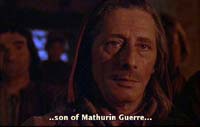 |
01:58 |
2 seconds |
Another CU, stationary camera, now of Martin's father (?). |
Names in voice-over and subtitles are being matched to the faces of characters. |
| 13 |
 |
02:00 |
3 seconds |
Another CU, stationary camera, of Martin's mother |
Names in voice-over and subtitles are successively being matched to the faces of characters. |
| 14 |
 |
02:03 |
5 seconds |
Another CU, stationary camera, of the priest. |
Names in voice-over and subtitles are successively being matched to the faces of characters. |
| 15 |
 |
02:08 |
14 seconds |
CU of hands of the married couple before we see their faces, stationary camera.
We hear Martin in voice-over as he repeats the priest's Latin marriage vows. |
The longer length of this shot further establishes the capacity of film to be intimate to its object while still withholding or calling attention to what we want to see but can't (yet) see. Moreover, Martin's voice-over gives him some authority but also distances him since Bertrande's hand and the ring become the visual center of the shot. The unusual practice of the groom putting the ring on each of the bride's fingers instead of just the ring finger may strike us as amusingly quaint and cute. |
| 16 |
 |
02:22 |
2 seconds |
Medium shot, camera stationary; we see the stepfather / uncle
here, who is not yet named but who becomes a major player. |
A somewhat odd eyeline shot of a man (Maurice Barrier) who is still a stranger to us and who is almost directly looking at the camera. |
| 17 |
 |
02:24 |
3 seconds |
CU, stationary camera, of Martin's mother. The shot is an eyeline match with the one before it, but the mother gets a closer close up than her husband did. |
Shot 17 allows us to read it and the preceding shot as an eyeline match. Based on the smiles of the characters, we may now infer that the man in shot 16 is the mother of Bertrande's second husband.(We get no corresponding exchange of looks between Martin's parents.) How did the first husband die? Like Bertrande, Martin's mother gets more attention from the camera than her spouse does. |
| 18 |
 |
02:27 |
3 seconds |
Medium CU of Martin (Stephane Peau). He recites his vows. |
We now see Martin's face for the first time, two and a half minutes into the film. We also realize that we have moved back in time before the time of the film's title. Martin has not left yet. We are getting an explanation of why he will have left (the only thing we can safely guess will happen) before we can wonder about his return. Again, the film focuses as much on the future as it does on the past. Martin's outfit also shows that he is from a family with some money. |
| |
 |
02:30 |
6 seconds |
A matching CU of Bertrande (Sylvie Meda), on the opposite side of the screen. She recites her vows. |
More continuity. The camera is closer to Bertrande than it was to Martin in the preceding shot and she occupies more of the frame than did Martin; the shot is also held three seconds longer, twice as long as the shot with Martin in it. Bertrande's similarly red costume shows her family has some wealth as well. |
| 19 |
 |
02:36 |
3 seconds |
A second CU of the married couple's hands, recalling the first CU of the ring on each of Bertrande's fingers during the vows. |
Bertrande's hand clasps, her ring visible, his (we see her nudge him later); she is already trying to reassure him. We also get more of a sense in the wedding bed that Martin is being smothered by women, who are too close and intrusive for his comfort. |
| 21 |
 |
02:39 |
3 seconds |
Continuity shot, medium CU of priest as vows are completed. |
The priest in this sequence seems neutral, but he gradually sides with the uncle against the fake Martin (Pansette). His proximity to the married couple and to the camera retrospectively later may give him some authority as a witness, and he later correctly identifies Martin as an imposter. But our sympathies are with the women who take Pansette's side. (The priest's whipping and exorcism of Martin and Bertrande follows the grandmother's prior failed attempt to heal Martin, and Bertrande says the priest's exorcism was effectual. The grandmother is the one woman who dies during the course of the film). |
| 22 |
 |
02:42 |
5 seconds |
Continuity shot, medium shot as vows are completed. |
Martin and Betrande turn toward each other at the end of the shot, but we don't see them kiss or know if they do kiss. Again, the film stimulates our desire to see and know something that it does not let us see or know. Later, the film makes a similarly abrupt cut when Martin turns away from Bertrande instead of turning toward her to consummate their marriage. We don't know if she stopped talking or why he is disinterested. |
| 23 |
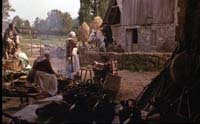 |
02:47 |
11 seconds |
Shots 23-27 constitute the second prologue. Long shot. We return to the rider and a voice over; still no music; in
effect, we get a second beginning, a second prologue with the narrator's voice-over. |
Women are in the foreground. Is this shot Bertrande's point of view from inside the house? The shadows in the foreground give the shot a sense of interiority, as if the camera were not hidden from the man on the horse. We later see Bertrande inside this house when Coras comes to interview her. If this shot is already her point view, we can only surmise that upon a second viewing. (Bertrande's point of view is sometimes difficult to establish. When we see her first flashback, we discover that she cannot have been present for most of it as she only first appears in the flashback at the house after the villagers have "castrated'" Martin when he is dressed as a bear.) |
| 24 |
 |
02:56 |
4 seconds |
MC, camera stationary, a woman is in the foreground here; a pig and another woman (a cook) appear in the
background. |
The male voice-over in this scene gives us a new claim for the authenticity of the story and for the potency of male speech. The dead, gutted pig and woman perhaps form an ironic counterpoint. |
| 25 |
 |
3:00 |
11 seconds |
The camera angle is somewhat low, the camera medium close up. The rider, having dismounted, carrying writing desk and then his roll of paper from his
saddle. |
Are we getting history raw here? Or are the (history) books (about to be) cooked? |
| |
 |
|
|
The camera pans right in order to follow the rider . . . |
The phrase "true story" resonates here: what is the truth between truth and narrative? Truth and fiction? We also are given attention about genre here, negatively. "True story" is defined against "tale of adventure" and "imaginary fable." "Histoire" in French may means both story and History. |
| |
 |
|
|
. . . as he walks into the building next to the women. |
The voice-over (3:02 to 3:17) begins the story with a relatively specific date (one August Sunday), marking a beginning: "It began one August Sundayi n 1542 . . . in the village of Artigat, county of Foix in the reign of Francis I." But the narrator's oral version, while reinforcing and clarifying the narrative thus far (this is the Sunday mentioned), is also in some degree of tension with the film's narrative. The voice-over uses a past tense, but the film is in the present tense. The voice-over gesture of beginning the film by declaring when it began also occurs a bit late (like the notary's arrival after the ceremony has begun), since the film has already begun. Moreover, the film has already begun in the preceding sequence showing the wedding, and the priest already gave us some of the same information, some of it more precisely "On this St. Michael's Sunday in the church of Artigat" (in contrast to "One August Sunday"). Place and time are marked differently for the local villagers at the wedding, in any case, than they are for the film audience and narrator. |
| 26 |
 |
03:11 |
4 seconds |
Low angle shot of an unidentified man, persumably a member of one of the two families, on the balcony. Continues the somewhat low angle of the notary, shot 34. |
We'll see this same shot of Bertrande and of Martin's father later when he throws money to the villagers who are harassing Martin and Bertrande because Martin is impotent. |
| 27 |
 |
03:15 |
5 seconds |
MS (Medium Shot), camera stationary. |
Again, women are prominent in the shot. The closer we get to the story, the more we also seem to be moving toward women. The dogs, one of which we saw in shot 7, are playfully fighting, and one growls after the voice-over is finished. |
| 28 |
 |
03:20 |
12 seconds |
Shots 28-37 constitute the second beginning. MLS. We have entered the house and see the notary; the priest quickly
comes into view; the camera moves slightly to accommodate him. Candles are sued for lighitng (this is probably anachronistic as cnadles were very exepnsive and used at night.) |
This is another static shot, like the opening. |
| 29 |
 |
03:42 |
4 seconds |
MCU, camera stationary. |
Another shot of women, both of them doing domestic work. One, the servant Catherine, is making bread. Catherine is the narrator of the novelized screenplay published by Jean-Claude Carriere and Daniel Vigne. |
| 30 |
 |
03:48 |
3 seconds |
Reaction shot, MCU. See matching shot 36. |
In this shot, Bertrande is in the foreground, happy and attentive to the notary's reading of her dowry; Martin is withdrawn, his head down. Bertrande seems happy to be moving up socially, emotionally, and financially into adulthood. The film is already using differences in screen time given to actors, their position in the frame, their gestures, and their proximity to the camera to suggest both differences in their characters' responses to getting married and that Bertrande (as a woman) will be the central character in this story. |
| 31 |
 |
03:51 |
5 seconds |
Close up of Martin's father signing the contract. Camera is stationary. |
Only the tip of the feather (quill) shows. Compare shot 35 (the other father holding the quill). |
| 32 |
 |
03:56 |
10 seconds |
We see Catherine wipe her hands and realize that this woman
is a servant. The other woman is the grandmother, who we will learn more
of shortly when she tries to help Martin become sexually potent. |
A fair amount of time in this static shot is devoted to two women, and the time given obviously cannot be explained in terms of the male gaze (he obectification and eroticization of women as spectacle). No older men are around, except for the notary. Wives appear to outlive their husbands. |
| 33 |
 |
04:06 |
4 seconds |
Medium close up of Martin's father signing the contract. |
His calling out to Catherine for a round of drink establishes him (and men) as an authority figure. The grandmother is out of focus in the background. |
| 34 |
 |
04:10 |
5 seconds |
A man with bagpipes pops in unannounced. Camera is stationary, low angle (the third time a low angle has been used for a man--see shots 25 and 26). Good timing. |
This is the first music we have heard since the credits ended (shot 8); it is mildly disruptive, as was the first note of the film when the title of the film appeared. We will hear similar, even more disruptive music later during the charivari. |
| 35 |
 |
04:15 |
5 seconds |
Medium reaction shot of Bertrande's stepfather, amused, gesturing with the quill as he speaks jocularly to the bagpipe player. |
Here the feather shows more fully than it did in the shots with Martin's father (shots 31 and 33). Bertrande's stepfather is in the center of this shot (35) and commands the frame. His authority is later undercut as he tries and fails to mediate between Bertrande and his wife after she returns to the house having closed the barn door. |
| 36 |
 |
04:20 |
4 seconds |
A matching reaction (shot 30) of Bertrande and Martin; both are amused. |
Martin is in the foreground and is happy for the first time. But Betrande is still in focus and she nudges him to show her interest and perhaps to reassure him further. She upstages him a bit. She is the only woman who speaks during the opening two prologues nd two beginnings. |
| 37 |
 |
04:24 |
14 seconds |
The MCU shot
starts out with the camera focused on the signing of the marriage contract . . . |
The asymmetry between the shots of the two fathers' relation to the quill is reinforced here as we see only Bertrande's stepfather sign his "name" (not a mark, but a small chicken, another animal). Writing is important enough for the camera to track the movement of a document. |
| |
 |
|
|
. . . and then Pierre picks it up and hands it over, finished, to
the smiling notary, who happily proclaims "un bon event." |
As with the shots 31 and 33 of Martin's father when he signed the contract and the beginning of this shot (37), the camera's focus at the end of the shot is on the person closest to the written document. The characters in the background of the shot are out of focus, and the father is no longer in the frame. |
| 38 |
 |
04:38 |
|
The beginning of a new sequence about Martin's failure to consummate the marriage. Cut to Bertrande and Martin in bed as the priest blesses them, camera pans slowly to the right. |
Marriage is surprisingly public as the wedding guests appear to have invaded the room where the couple will (fail to) consummate their marriage. Martin's lack of privacy (an anachronism?) and early age may partly explain his impotence. Betrande later sleeps in the same bed with her young children. (Compare Vermeer's bed in the dining room in Girl With a Pearl Earring.) though the camera remains present after the the couple are left alone, we don't learn much about the relationship. We do learn that knowledge of the tale and knowledge of sex are linked. |
Part Three: Film Clip Analysis
This clip constitutes a complex and somewhat enigmatic even mysterious transition from prologue to film narrative, initially, if only momentarily, withholding information about the characters we see as it sets up a number of concerns about film, repetition, doubles, mistaken identity, impersonation, narrative, memory, romance, and history that are followed up in the rest of the film. Someone, if not Martin Guerre, always seems to be returning in this film. The film does not begin as historical films usually do (with a voice-over or credits at the start followed by the film narrative proper; for examples, see Elizabeth, The Messenger, and The Mission). Instead, it questions how the beginning of this story is to be established by giving us a double prologue and double beginning The opening sequence (shots 1-7) with credits constitutes what seems like a prologue, and when we cut to the Church (shot 8), it appears that the film has begun with the beginning of a wedding cermeony. But in shot 23, we return to the rider, now dismounting, and we get a new, second prologue in voice-over (shots 23-27). As we cut inside the house, we see that the rider is a notary, and the film effectively begins again for a second time as a legal proceeding (signing a marriage contract) repeats the wedding ceremony (giving a ring and exchanging vows). In addiiton prologue and film beginning, the opening four and half minutes of the film also complicate our sense of when the story of / this film begins by blurring if not deconstructing the difference between prologue and film narrative: the second prologue (shots 23-27) occurs, for example, in voice-over as the film narrative continues; similarly, the first "beginning" (shots 8-22) begins, as it were, with what amounts to a prologue (shots 8-11).
The Return of Martin Guerre's double beginning and double prologue may reasonably be broken down into four parts:
1. The first prologue (shots 1-7): an unidentified man on horseback arrives at a village as the credits roll.
The opening, first prologue (with film credits) alternates between static shots with the rider moving out of the frames and panning shots of the rider as he rides or walks toward or in the village, shots which also come to a rest and continue even after he leaves the frame. By withholding information it also makes us want to obtain, the film increases dramatic suspense and mystery. It also invites reflection on the relation between film and (this) history. It's as if the camera cannot keep pace with the notary, who we may be invited to read as a figure of the historian history (the voice-over begins as see the notary take his saddle and papers with him) and the historian as writer of records. The clip as a whole also provides up some closure--with music intervention (which recalls the first use of music in the film, then extradiegetic)--and with the signing being finished--"un bonne event" ( a good or happy event). Yet the notary / writing / history also comes after the event--the writing scene occurs after the oral vows of the religious ceremony. Like history, the film too is playing catch up, lagging behind events either in the past or the future of the past that outrun (or outride) it. Perhaps we, as spectators cannot quite keep pace with the film either (even the lingering pauses in the opening credit sequence generate more questions rather than give us interpretive breathers).
The film's establishing (long) shot of a man on horse riding a stream and moving toward the camera, held for a relatively long time (23 seconds), immediately raises a question; who is this man? When, just after the rider leaves the frame, the title of the film appears and the music dramatically begins in concert, the question becomes more interesting, if not pressing as others follow: Is this man Martin Guerre, then? Is he returning at this moment? Where is returning to? Where is he returning from? How long has he been gone? Where has he been? The camera remains stationary as the man rides closer to it, and initially, the film seems to establish its ability to get at the truth through the camera's proximity to what it films: it brings the past, particularly the human face, closer to us. Truth is linked to what is visible and readable. Yet as the rider moves out of the still stationary camera, the film calls attention to the limits of the film to access the past and the future, to answer (immediately) the question already raised, who was that rider? The film implies that even when the camera moves, the answers to our questions will remain partly unavailable, off screen, out of reach. (Even when we learn that the rider is a notary who has gone to the village for a wedding, we know next to nothing about him.)
The fact that the rider is shot in a stream also suggests that he is in an unambiguous position, crossing from one side to another. As he rides through a pond and gets closer to the village center, the waters become literally muddied; the story will perhaps become metaphorically muddier as well. (Contrast the much simpler opening of the remake, Sommersby, which begins with the imposter burying someone and then follows him as he walks home in the Winter as the credits roll. In the opening, the camera gradually reveals a dead hand, letting us know that Gere's character, soon seen in close up and matched to the title "Richard Gere," is burying him, though it leaves open why he is burying the man and why he is doing it alone, without any ceremony: did he murder the dead man? Or was he caring for the dead man, who has died of sickness or wounds?)
The opening establishing shot of The Return of Martin Guerre is also mirrored in reverse at the very end of the film, as the camera pans left on the court members and their entourage as they leave the village after Arnauld's execution. In the final shot of the film, the camera gradually comes to rest at a slightly elevated position and the credits roll while these people exit the frame. This is the second of two epilogues, the first of which is done voice-over, the reverse of the order of the film's two prologues. The ending of the film also mirrors the beginning in providing a false ending. After the trial, it seems Coras' reappearance on horse and alone at the village seems like an epilogue, a flashforward. his questions are in the past tense and it seems like he doing a post-mortem on the case for his own reasons. It turns out, however, that he has come to the town for an official function, to see Arnauld's execution. After the interview, we see other officials have come as well. The conclusion seems somewhat anti-climatic and bleeds (or burns) into the voice-over epilogue.
The opening credits of the film also opens up the question of how writing and images are to be read, whether one informs the other the other or is more authentic than the other. The title of the film suggests that the rider may be Martin Guerre. (The first close up of the adult Bertrande, looking like an animated Renaissance painting, is matched to a voice-over of her name.) But as we will shortly learn, he is not.
More questions arise as this prologue continues and the man, seen mostly in long shot, rides through a small village. He encounters a group of women, but says nothing to them. Does he know them and ignore them? Or is this his first time and he is a stranger? Then he encounters a group of men and waves "Hello" to them. So we learn that he is not a stranger, but may wonder why he didn't greet the women. A number of animals--dogs and pigs-- are in the foreground of these shots. (See the 1993 film The Advocate [a French / UK co-production shot in France, dir. Leslie Megahey] for a similar opening in its use of animals.) The white roll of paper in the rider's saddle makes clear he is a man of some authority, yet he does not seem to have authority or coercive power over the villagers since many seem to ignore him. The notary is also interestingly both a central figure (his presence is required for legal rather than social reasons) and marginal (seen outside the village, in the stream, and not seen again after the signing of the wedding contract). We will later see that Judge Coras also occupies a similarly and more acutely paradoxical position at the margins and center of the story.
During this first prologue, the credits roll and constitute a kind of "paratext" (Gerard Genette, 1987), or critical commentary. The title of the film, as we have seen, initially suggests a link between the rider and Martin Guerre. It soon turns out that there is no link, and we may well have any abandoned the thought by the time Martin is identified in the Church. In other places, the credit and image invite reflection--is there a reason that the pigs alone are in the frame when "Un film de Daniel Vigne" appears? Is this a comical self-deflating commentary? There a reason that the credit to Natalie Zemon Davis appears after the rider has left the shot and only women are in the frame (the woman historical consultant speaks for and with the women in the film)? So questions about how to read images and words, which is truer, are also set up here, although quietly. Soon, we will see Judge Coras enter and his secretary take dictation, and Bertrande's (Nathalie Baye) words and flashbacks aren't so clearly co-ordinated.
The credits also suggest another recurrent theme-of doubles and double reading. Note that the name of the director, Daniel Vigne, appears twice, first as co-screenwriter and then as director. We first see Judge Coras (Roger Planchon) also riding a horse, looking like the rider (a notary, as it turns out), and he appears in Bertrande's house with a second authority who looks like him. Even before we get to the question of Martin Guerre and Arnauld de Tilh (aka Pansette, played by Gerard de Depardieu) as doubles, we see a number of doubles. (The film itself falls into two large parts, the first involving Bertrande's flashbacks and the second after the time of the film catches up to the present of Bertrande's memories.)
2. The first beginning (shots 8-22): The marriage ceremony.
After the credits end, the film cuts to a marriage ceremony in what must be a church, and the film narrative proper appears to begin not only because the credits have ended but because of the way this next sequence is shot (more traditionally). It involves much more conventional camera shots (close ups) and matches of voice to face. Continuity is established between shots. Film conventions invite us to infer a flashforward from the time we see the man on horseback to the time of this scene, where we expect to find him, after he would have arrived at his apparent destination. We hear a voice over initially, who turns out to be the priest. This section of the film might itself be considered double as the first three shots (8-11) also constitute a veiled prologue for the viewer. The voice-over prologue in the next sequence repeats some of the information given by the priest at the beginning of this scene.
We might be wondering where the rider went, asking what is the relation between the external space (the village) and this internal one, presumably of a church, but a church not seen in the opening shots of the rider. During the marriage ceremony sequence, we get matches between faces and names, but the rider is not among them. There are no enigmas here, though we may be wondering where the rider went.
3. The second prologue (shots 23-27): The narrator's voice-over as the notary dismounts his horse and ges into a house.
After the wedding ceremony, we get a second prologue as we hear a voice over telling us that this is a true story. This unidentified speaker is reading from the bookseller's preface to the second edition of Judge Coras' Arrest Memorable, the book, an account of the actual case, on which the film is based. We do not know this, however, and the film invites us to link the male voice to the male notary, voice and writing. The links between voice and writing become even stronger when Judge Coras appears later to interview Bertrande. The notary is identified with the historian as storyteller through the voice-over. Note: the status of the historian as storyteller is complicated not only by themix of story and truth but because the male voice over here delivers lines not from Judge Coras' account (not from the author as storyteller and / or historian) but from an advertisement written by the bookseller. The lines are not from the text of the Cora's book but from its paratext. Coras' book, the historical source for the film is itself doubly double, a mix of text and paratext and a mix of narrative and annotations. So too the double prologues involve a double reading of the film, both as a retelling of the Martin Guerre story and as a story or allegory of adapting history to film. (Davis speaks of Bertrande playing a double game and of her own work as film consultant and as author of the book, The Return of Martin Guerre, as a double game.)
After the marriage ceremony, we move back to the rider, who we have now perhaps already forgotten. What had seemed like a flashforward turns out to have been a parallel event happening at the same time. What had seemed like a movement from prologue to beginning now goes back to (what is no longer) the prologue but which becomes a second prologue as the voice over tells us this is a "true story."
Though we can follow the linear narrative, the story does not have a clearly marked beginning--we are told the story began after it has already begun. Past, present, and future, like prologue and tale, remain embedded in one another. Martin Guerre is returning not only as a person in the story but as a story (a story that returns to us, is being returned to us, by the film). The doubleness lends an uncanny, haunting, gripping aspect to the film. Has the story found us? Or have we found it?
4. The second beginning (shots 28-37): The signing of the marriage contract.
In the next sequence, again inside, we see the notary, who is explaining the terms of the contract, doing the marriage all over (a civil signing follows a religious ceremony). Voice again tells us something. The notary has a strong accent when he says "Ber-tran-duh de Rols. " He puts a heavy emphasis on the last syllable in "Bertrande." His accent marks him as an outsider. By now, the characters are all sorted out, and apparent enigmas have turned out to be momentary. The rider is a notary, not Martin Guerre. The young man getting married is Martin. The only lingering questions may be about the meaning of the film's title: why the "return" of Martin Guerre? Why is he going to leave? When and why will he eventually return? Everyone seems pretty happy, and Bertrande seems to be happy to marry him. Martin remains somewhat distant, however, and Bertrande is solicitous. (One noticeable thing about this scene is that we only see one of the two fathers signing his mark on the contract. Writing becomes here a metaphor for patriarchal potency that distinguishes two fathers: the weaker one will die soon; the stronger will triumph.) The film links marriage to media (speech acts and written contract). Marriage is from the start both public, intimate (close ups) and, distant (the notary has come not to attend the religious ceremony but only to have the marriage contract signed--by the fathers, not the children getting married). Gender gradually becomes significant in this clip as well. Though the men are the more active characters, the women either silent or ordered about by men, the film gives the women, particularly Bertrande and her mother, slightly more screen time than the men and positions them more closely to the camera than it does the men. Reinforcing the asymmetry between the two fathers, the film creates a tension between the patriarchal structure of the village (men rule) and the way both sexes are filmed (women rule, ad not as mere sex objects of the male gaze; knowledge, desire, and sexuality are all interwined).
Summary: This clip from The Return of Martin Guerre, a film concerned with time, narrative, remembering, and forgetting, is already allegorizing and partly performing these concerns, making film and the spectator's interpretive abilities and memory part of the story. Getting at this film about history (and perhaps, more generally, getting at history) involves backtracking, false starts, missteps and mistaken inferences, retrospective readjustments, patience while awaiting deferred answers, and sorting out who's who, which characters are major ones and insiders, which minor and on the margins or outside. In this clip, we have a small, very quietly constructed opposition between film and voice (closeness, intimacy), on the one hand, and writing (here distance, strangeness, but soon to include duplicity, forgery, and empowerment). These concerns continue to be raised during the film. Both Coras and Arnauld are linked to writing in the film, and they also become intimate in different ways with Bertrande through their literacy. Both also die violent deaths. Though various enigmas are resolved in the opening double prologue, as they are in the film (we learn who the real Martin is, who the imposter is), other enigmas remain: when did Bertrande know? Why did she cave in at the trial? Can we believe she is telling the truth to Coras when he visits her and talks with her alone after the trial and before Martin's execution? More broadly, many questions remain about the capacities and competing claims of film, writing, the law, proximity, and voice to establish the truth, to give us access to the past.
Paintings as sources of shots, lighting, and costume in The Return of Martin Guerre
